Korean Seaweed Soup (Miyeokguk)
Seaweed soup (miyeokguk) is a deeply comforting Korean dish made with dried seaweed and beef simmered in a savory broth. It’s light, nourishing, and rich with meaning — served for birthdays, postpartum recovery, or whenever comfort is needed.

Growing up in Korea, I always looked forward to a warm bowl of miyeokguk, Korean seaweed soup simmered with tender beef and fragrant sesame oil. Every year, my mother made it on birthdays for each family member, a simple bowl that carried so much love and meaning. It wasn’t fancy, but it reminded us of her care and strength.
Now, as a mother myself, I treasure that same tradition. My version of beef seaweed soup stays true to how my family has made it for generations, using rice water to create a light yet deeply flavorful broth that’s nourishing and comforting at once.
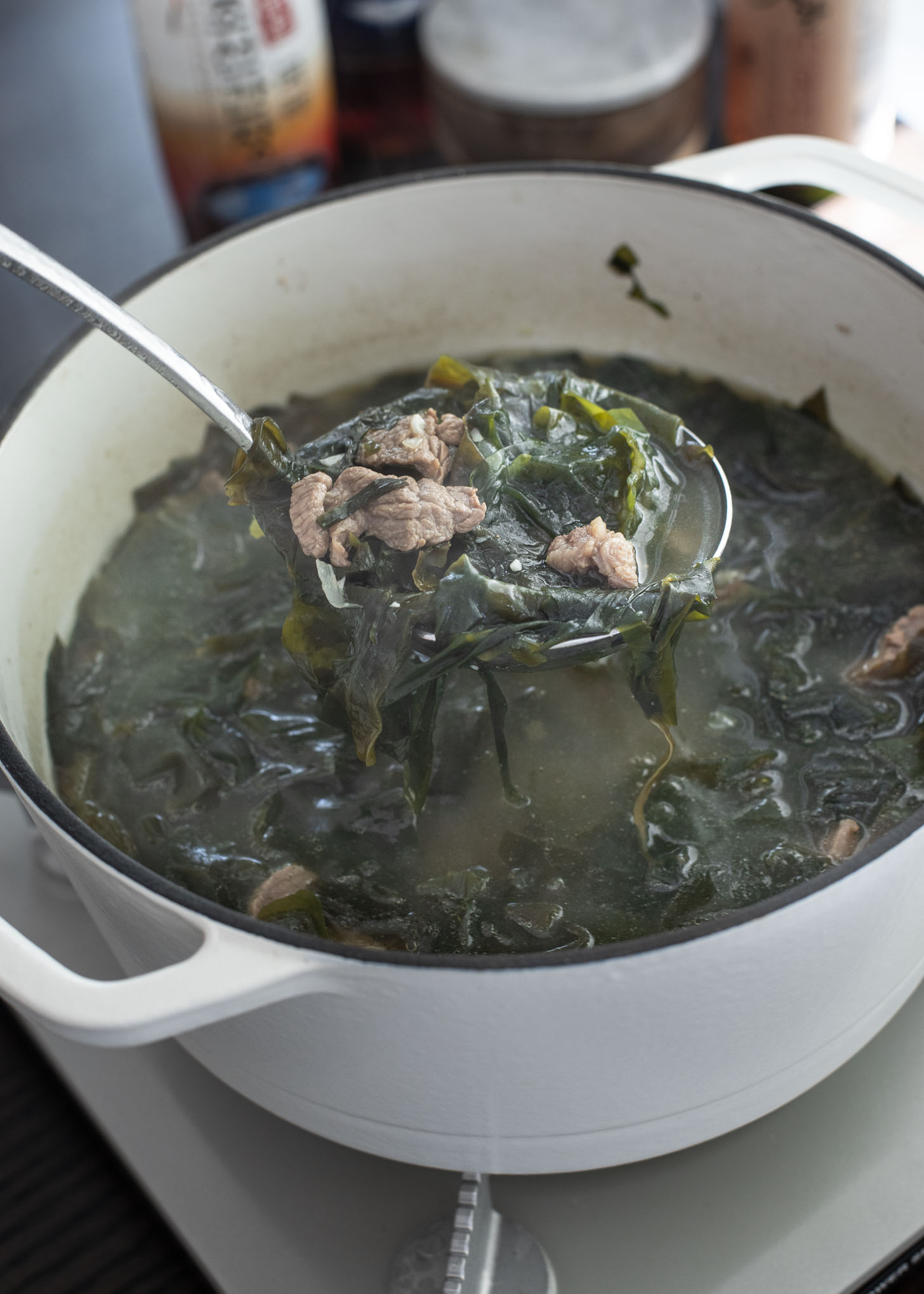
The Meaning Behind Miyeokguk
While many sources describe miyeokguk (미역국) simply as seaweed soup, to Koreans it holds a far deeper meaning. It’s a dish intertwined with gratitude, family, and life’s milestones.
Traditionally, new mothers eat it after childbirth to regain strength, thanks to the nutrients in seaweed that support recovery. Over time, it became the birthday soup that children enjoy each year to honor their mothers’ sacrifices — a quiet, heartfelt way to say thank you.
Key Ingredients & Flavor Tips
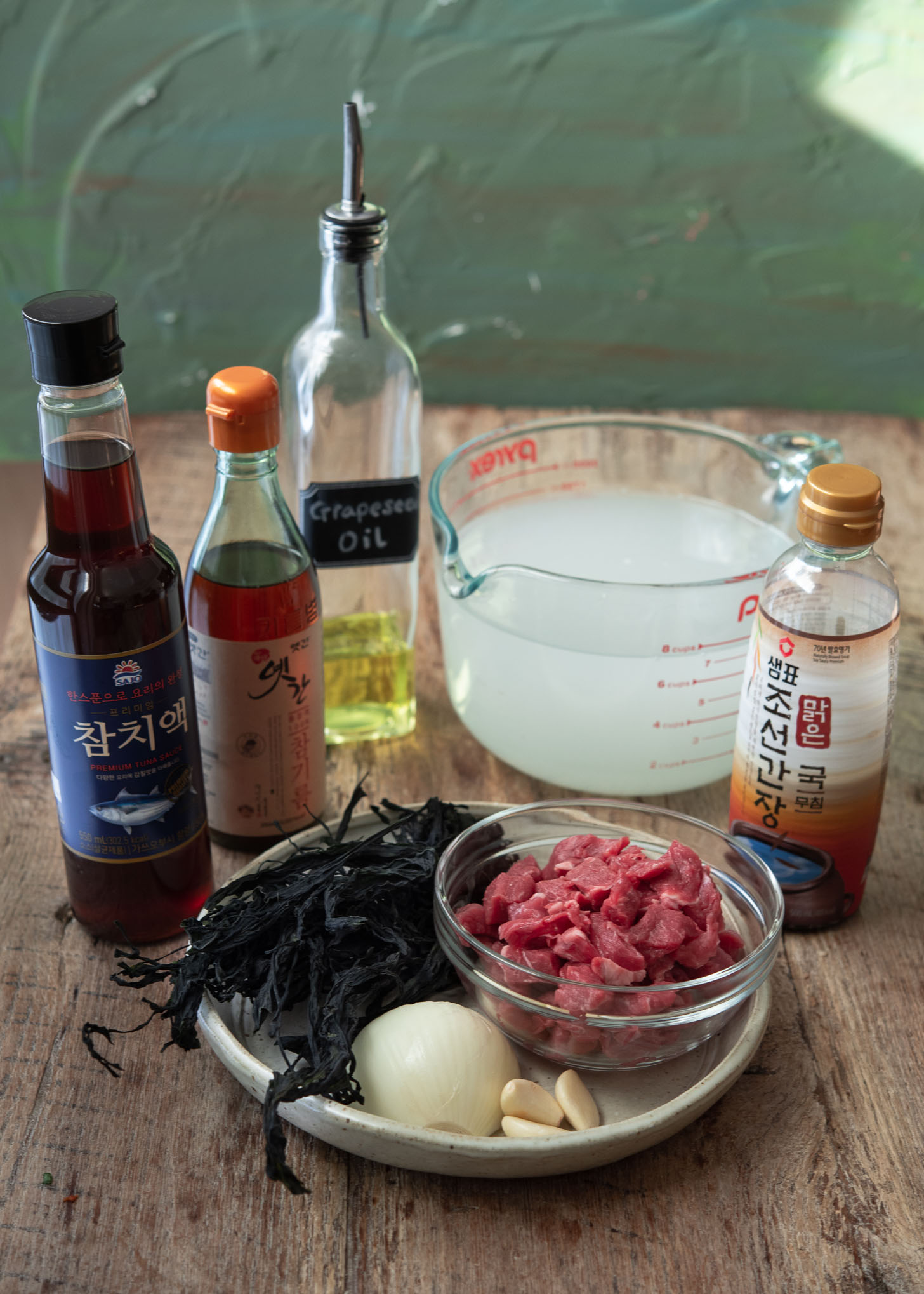
Miyeok (dried seaweed):
Look for thin, dark green strands of Korean miyeok rather than thick, coarse seaweed. Good-quality miyeok softens quickly and turns silky without falling apart. I prefer Korean brands labeled guk-yong miyeok (for soup), as they release a cleaner, ocean-fresh flavor than wakame varieties used in Japanese miso soup.
See my seaweed egg drop soup or cold seaweed cucumber soup recipes for more ways to use this Korean seaweed.
Beef:
For authentic beef seaweed soup (miyeokguk), use small pieces of stew beef or brisket. A quick stir-fry in sesame oil before adding water brings out the deep, savory aroma that defines a traditional Korean broth. If you prefer a lighter flavor, trim excess fat or use leaner cuts.
Rice Water:
Instead of plain water, use the starchy rinse from washing rice — a home-style Korean tip passed down in my family. It gives the miyeokguk broth a gentle sweetness and slightly thicker texture that feels soothing and rich without adding salt.
Seasoning:
Season with Korean soup soy sauce (guk-ganjang) for a clean, savory depth without darkening the broth. Finish with a drizzle of toasted sesame oil for warmth and aroma. I sometimes add a teaspoon of Korean tuna sauce (chamchi aekjeot) for a subtle umami boost — a modern trick that enhances the soup’s complexity.
How to make Seaweed soup (Miyeokguk) with Beef


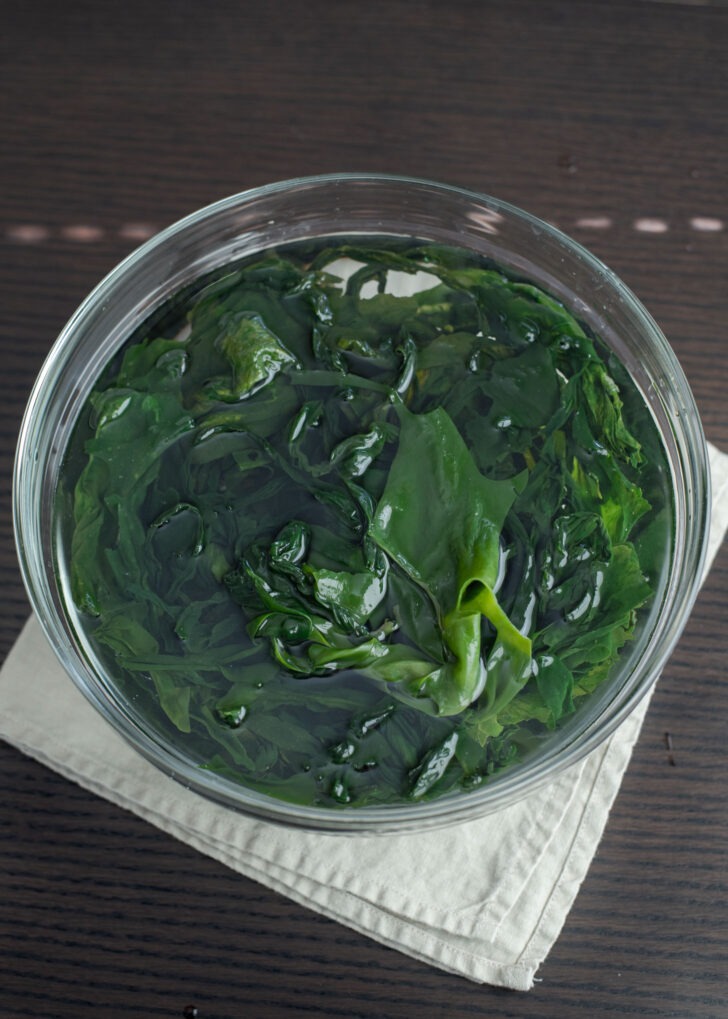
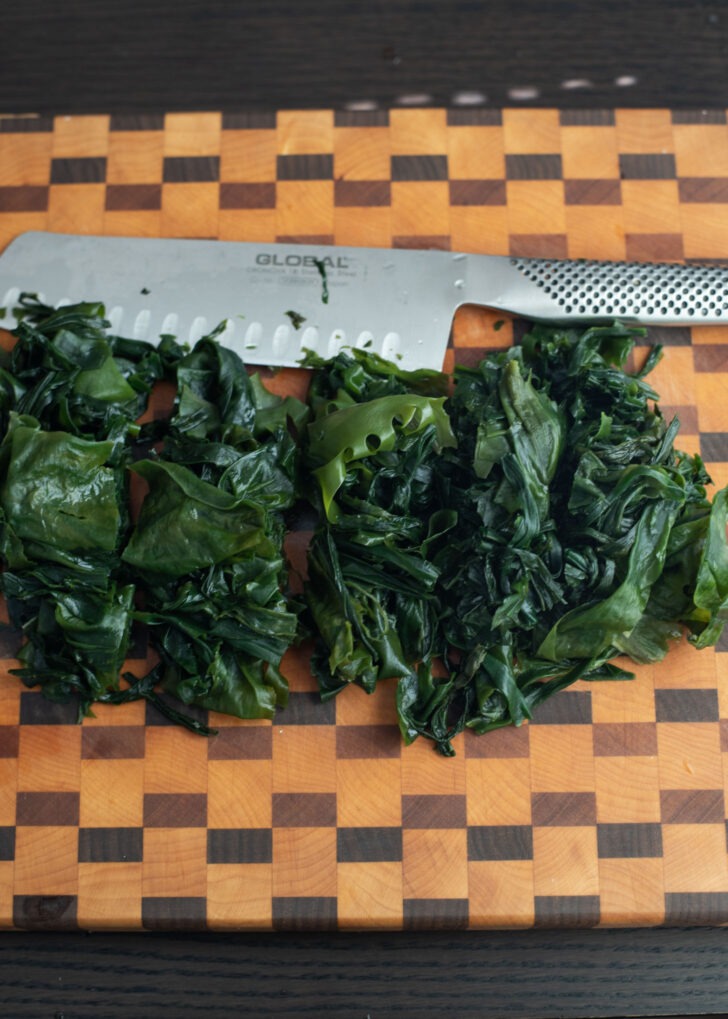
Soak the Dried Seaweed. After soaking, good-quality miyeok should expand several times in size and feel silky but still slightly firm. If it feels limp or overly soft, it’s been soaked too long. The deep green color is a sign of freshness.
Tip: Cut the rehydrated seaweed into bite-size pieces before cooking so it’s easier to eat and evenly distributed in the soup.

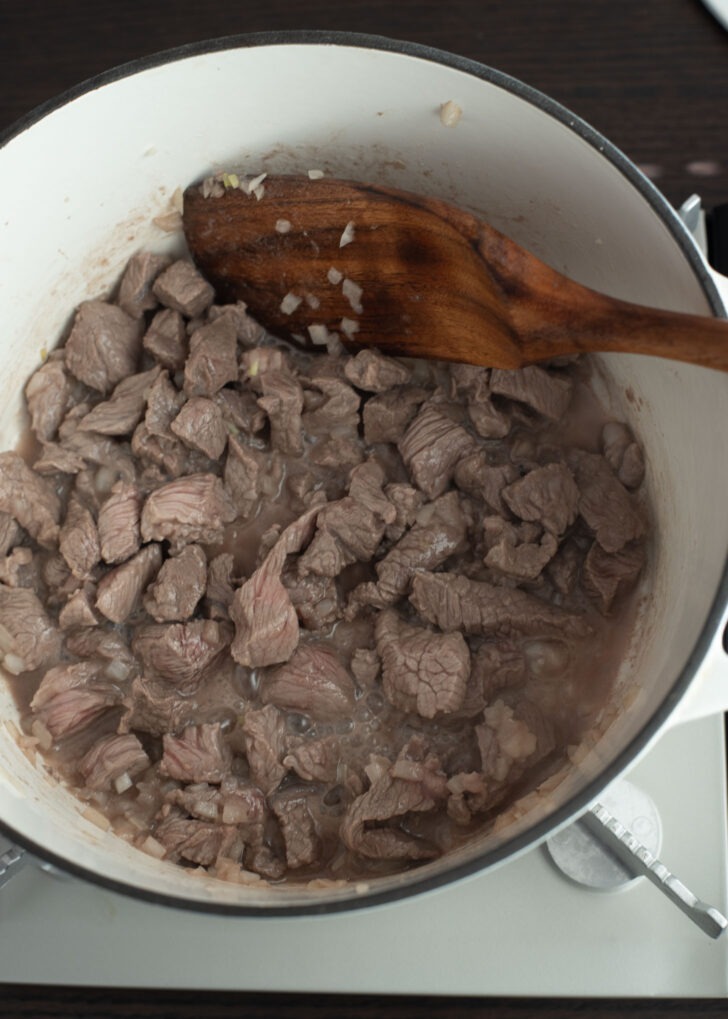
Sauté the Beef and Onion. Unlike most traditional versions of Korean seaweed soup, I like to add a little onion while sautéing the beef for extra savoriness and flavor depth. It subtly sweetens the broth as it cooks, making the soup taste rounder and more balanced.
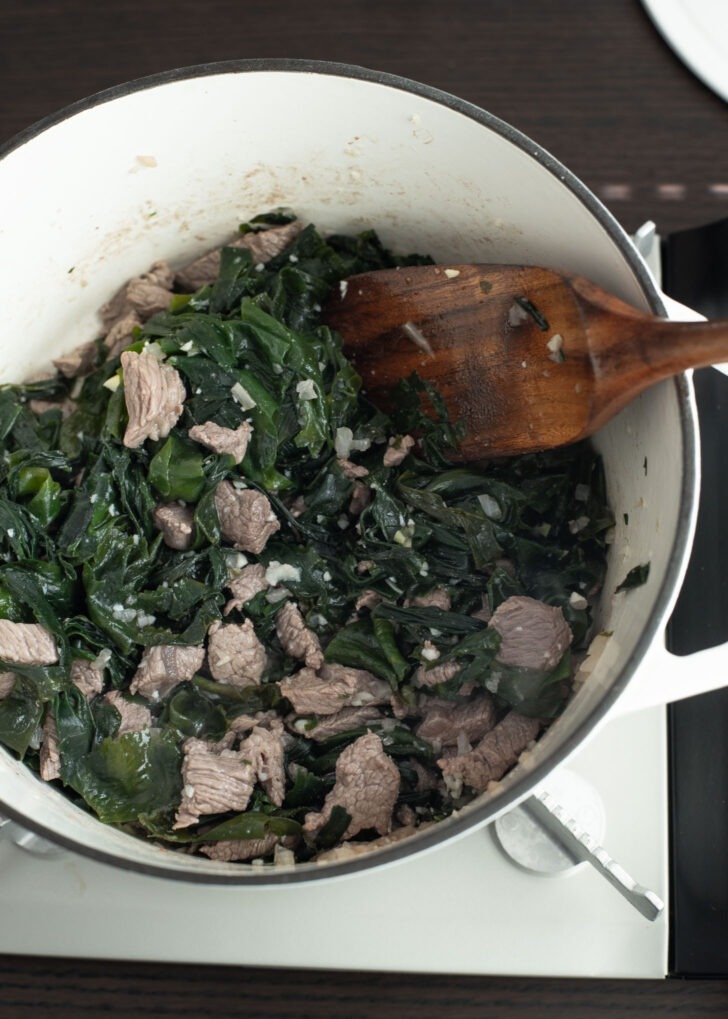

Combine with Seaweed and Rice Water. Let the soup simmer gently. The broth will turn slightly opaque — that’s a good sign. The seaweed should float softly and the aroma should be savory, not fishy.
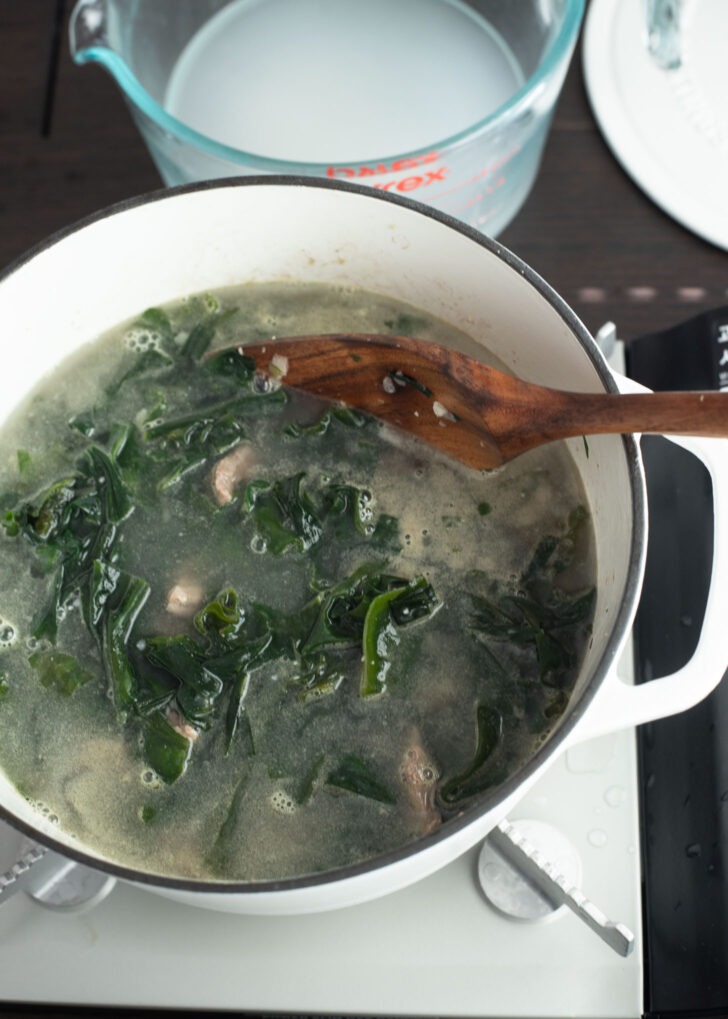
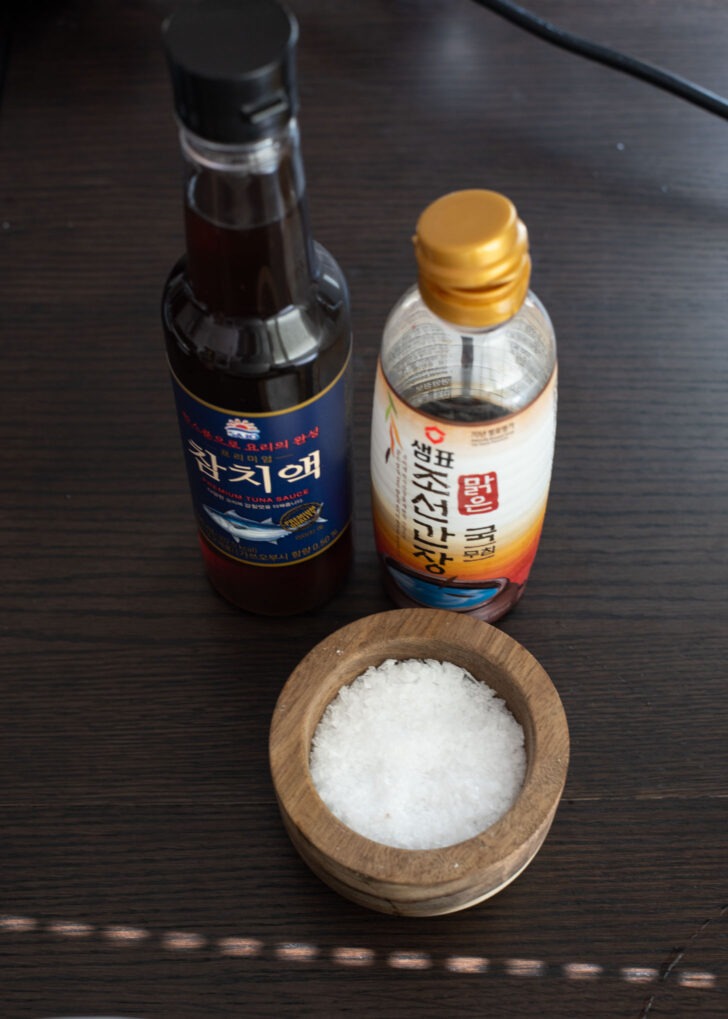
Simmer and Season: Let the soup simmer gently until the broth turns slightly opaque. Season lightly with Korean soup soy sauce (guk-ganjang), tuna sauce and salt toward the end. The broth should be clean, savory, and balanced — not too salty or heavy. A drizzle of sesame oil right before serving ties everything together.
Serve the soup hot with rice and kkakdugi (radish kimchi) for the classic Korean comfort meal.
Storage & Reheating Tips
Miyeokguk keeps beautifully for several days, and the flavor often deepens as it rests. I usually make a large pot and enjoy it throughout the week. It tastes even better the next day when the broth and seaweed have had time to meld.
Store leftover Korean seaweed soup in an airtight container in the refrigerator for up to 4 days. Reheat it gently on the stovetop over low heat rather than boiling. This helps keep the seaweed tender and the broth clean-tasting.
Freezing: Miyeokguk also freezes well. Portion it into freezer-safe containers, leaving some space for expansion, and freeze for up to 3 months. Thaw overnight in the fridge, then warm slowly on the stove.
If you enjoy light, comforting Korean soups, try my Beef Radish Soup (Soegogi Muguk) next.

Love this recipe? Rate it and share your experience in the comments below! On Instagram? Tag me to showcase your creation. For more delicious recipes, subscribe to our newsletter!
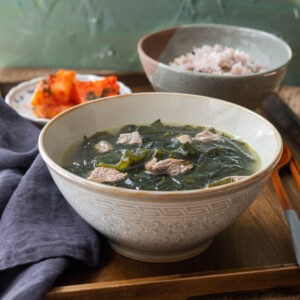
Korean Seaweed Soup (Miyeokguk)
Recipe Video
Ingredients
- 1 oz (30 g) dried seaweed (miyeok)
- 1/2 tbsp (7 ml) oil
- 1 tbsp (15 ml) sesame oil
- 1/2 (about 50 g) small onion, minced
- 2/3 lb (300 g) beef , stew meat, small pieces
- 2 cloves garlic, finely minced
- 2 tbsp (30 ml) Korean soup soy sauce (gukganjang), divided
- 7-8 cups (1.65–1.9 liter) rice water, or plain water
- 1 tbsp (15 ml) Korean tuna sauce, optional
- pinches salt, to taste
Instructions
- Soak seaweed in cold water for 10-15 mins, then drain and slice.
- Heat oil and sesame oil in a soup pot over medium-low heat. Add minced onion and stir-fry for 30 seconds. Add the beef and cook until no longer pink. Add the seaweed, garlic, and 1 tablespoon of Korean soup soy sauce; cook for 3 minutes
- Pour in rice water (or plain water) and stir. Cover with a lid and simmer for 10 minutes or until the seaweed is soft and tender.
- Season the soup with the remaining Korean soup soy sauce, Korean tuna sauce (if using), salt, and 1 tsp sesame oil. Serve hot with rice and kimchi.


Just made this today and it was SO good. 10/10 will make again!
Thanks Holly! I made some today using my mother’s recipe which is almost identical to yours. She typically didn’t add onion and used just sesame oil. I like to add korean radish (무) and just a bit of shredded carrots for color.
I like your wide range of traditional and non-traditional recipes. Thanks so much! 수고하셨습니다!
Hi Mark
Most people don’t include onions in seaweed soup, but I found it much better with them. It make the soup more savory. I also like to add a little cooking oil to sesame oil when I cook the meat, so that it can raise the smoking point. Sesame oil is not ideal for stir-frying or cooking since it has a very low smoking point. I appreciate your addition of carrots. Thank you so much for your comment. I’m glad that my recipe is identical to your mother’s.
LOVE seaweed soup! Your ingredient list does not show onions, but your instructions has onions… how much onions do you use?
Thank you for the delicious recipe!
Hi Nana
Thanks for pointing out the missing ingredient. I updated the recipe card. If you love seaweed soup, you will love this recipe. Thanks for your comment.
Hi, anyway to make the beef more tender? I’ve seen other recipes, but this is exactly how my mother in law in Korea made it, so I know it’s legit.
I tried soaking it in baking soda, but that was gross.
I wouldn’t recommend soaking the beef with baking soda to make this soup. Use thin sirloin beef slices instead of cubed stew beef. This is a rather quick soup and if you want the beef to be tender, you will need to use tender cut of beef. However, is using stewing beef, give a longer simmer time. That will help tenderizing the beef. Hope this helps. Let me know if you have more questions. Thanks!
My mom made me a ton of seaweed soup when I was nursing; so for 3 months straight, every day I ate seaweed soup. LOL
Hi there, I check your blog like every week. Your humoristic style is awesome, keep doing what you’re doing!
Thanks Les. I appreciate your sweet words!
I love eating seafood! When they`re in soup or crispy and lightly salted! This soup looks great.
Holly,
This soup is great. We always have seaweed soup with pork bones or tofu and have not tried to stew beef with it. I will have a try next time.
I’ve heard many times how healthy seaweed is, but I never eat it unless it’s with sushi or miso soup. I’m interested in cooking with it.
Simple and delish and similar to what my Malaysian cousin does.
I can almost smell this soup! I need a big bowl of this soup right now… I love seaweed and enjoy Korean beef and seaweed soup a lot. I will try your recipe next time!
I’d had seaweed dishes in restaurants, but never cooked with it. I definitely have to try this — looks so wonderful! Good stuff — thanks.
This looks great. My mom used to make this for birthday celebration in the family. Thanks for the recipe. I’m excited to try this out!
I am also a seaweed machine and would love love a hot bowl of this RIGHT NOW. Sounds like a great simple but high impact recipe.
http://thatumamilife.wordpress.com
Hello! I stumbled across your blog and love it! Thanks for sharing.
I have to laugh, I thought this was something my mom had made up!…She use to make this soup whenever someone was sick.. Unfortunately, I never appreciated it… The seaweed grossed me out.. Now, I would appreciate it…Korean soy sauce? never had/heard of it… we used the typical Kikkoman…
I am glad that you are appreciating seaweed now. Korean soy sauce for soup is literally soy sauce made for soup. It is different than regular soy sauce that we all know. It is saltier and more pungent. It adds a deep layer of flavor that is quite different than usual soy sauce.
I noticed in Korean dramas that when it’s someone’s birthday they get asked if they ate seaweed soup or someone makes seaweed sou for them Now I know how to make it : ) tks for the recipe.